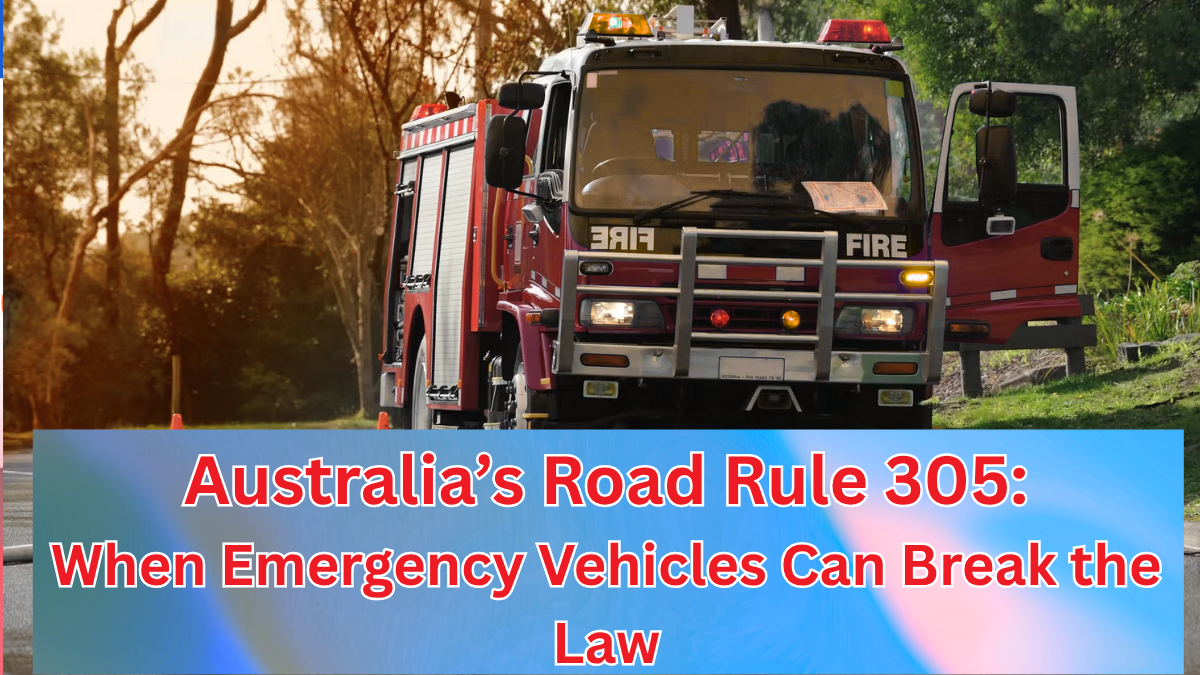When you’re on the road, it’s normal to expect that everyone—including police and ambulances—must follow the same traffic rules. But there’s a little-known yet crucial law that makes exceptions for emergency responders: Australia’s Road Rule 305.
Let’s break it down in simple terms and see how it impacts everyday road users like you.

What Is Australia Road Rule 305?
Australia Road Rule 305 is a specific provision that grants legal leeway to emergency vehicles—such as police cars, ambulances, and fire trucks—allowing them to break standard road rules in the course of their duties.
This rule helps first responders act quickly and efficiently in critical situations without being restricted by standard traffic regulations.
When Does Rule 305 Apply?
Emergency vehicle operators can only take advantage of this rule under strict conditions. Here’s when they’re allowed to override general traffic laws:
-
Responding to an emergency
-
Pursuing a suspect
-
Protecting public safety
-
Providing urgent medical care
And yes, those flashing lights and sirens usually mean Rule 305 is in play.
Key Scenarios Where Emergency Vehicles Get Exemptions
Here’s a quick table highlighting common exemptions allowed under Australia Road Rule 305:
| Action | Normally Illegal? | Allowed Under Rule 305? |
|---|---|---|
| Running red lights | Yes | Yes, if warning is given |
| Speeding over the limit | Yes | Yes, in urgent cases |
| Driving in bus or bike lanes | Yes | Yes, if needed |
| Stopping or parking illegally | Yes | Yes, for quick access |
| Driving against the flow of traffic | Yes | Yes, with caution |
These are road safety exemptions designed to help emergency workers save lives and maintain order.
But There Are Limits…
Just because emergency vehicles can bend the rules doesn’t mean they’re above the law entirely.
-
They must still drive with due care.
-
Sirens or flashing lights must be used appropriately.
-
Drivers must be trained professionals.
This balance between flexibility and responsibility ensures that traffic law and public safety go hand-in-hand.
How Should You Respond as a Driver?
When you spot a police car, ambulance, or fire truck flashing lights and sounding sirens:
-
Move to the left if safe to do so.
-
Stop and let them pass.
-
Avoid sudden moves or braking that could confuse others.
Understanding these police car rules can prevent accidents and help emergency services operate faster.
Why This Rule Matters to You
Even if you’re not behind the wheel of an emergency vehicle, knowing about Australia Road Rule 305 can:
-
Help you respond correctly on the road
-
Reduce the risk of getting fined or causing delays
-
Enhance overall traffic safety for everyone
FAQs
Q1. Can emergency vehicles ignore all traffic rules under Australia Road Rule 305?
No. They’re only allowed to break certain rules when performing official duties and must always drive responsibly.
Q2. What if I don’t give way to an emergency vehicle?
Failing to give way can result in fines and demerit points, as it’s considered a traffic law offense.
Q3. Are regular drivers ever covered under Rule 305?
No. This rule only applies to authorised emergency service personnel in official vehicles.
Q4. How do I know if Rule 305 is being used?
If the vehicle is using lights, sirens, or moving with urgency during a visible emergency situation, Rule 305 likely applies.
Final Thoughts
Australia Road Rule 305 isn’t about giving special privileges—it’s about empowering emergency workers to do their jobs in life-and-death situations. By understanding the rule and knowing how to react, we all play a part in keeping roads safer and saving lives.
Click here to learn more
